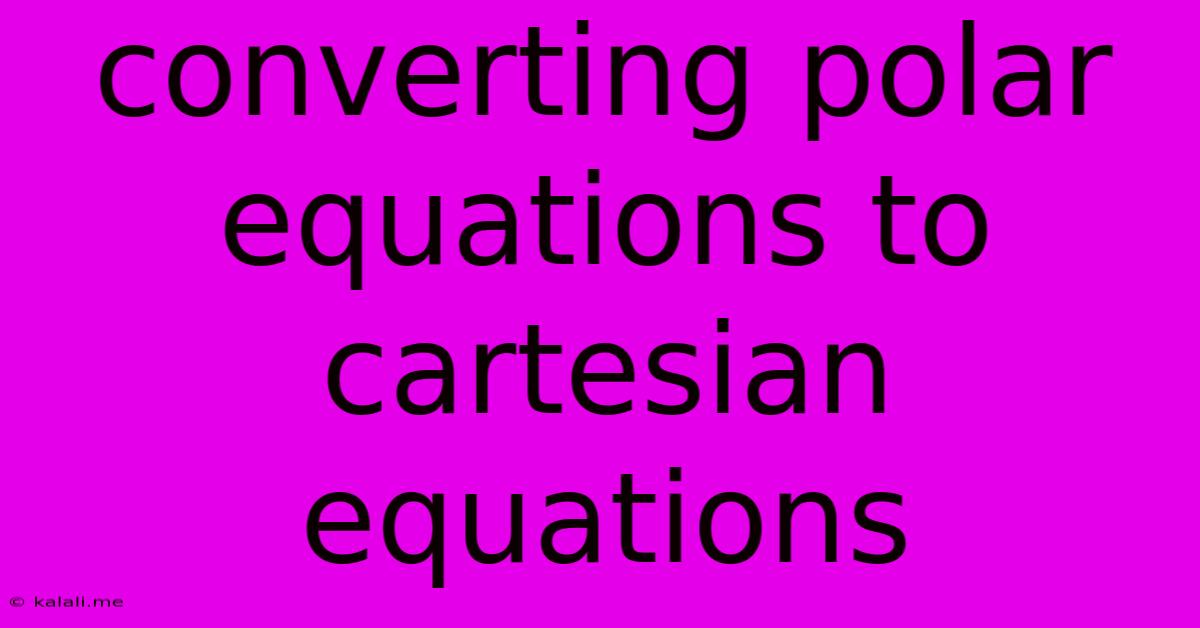Converting Polar Equations To Cartesian Equations
Kalali
Jun 05, 2025 · 3 min read

Table of Contents
Converting Polar Equations to Cartesian Equations: A Comprehensive Guide
Meta Description: Learn how to effortlessly convert polar equations to Cartesian equations using this comprehensive guide. Master the trigonometric identities and algebraic manipulation techniques needed for seamless conversion. Understand the process with clear examples and explanations.
Polar coordinates provide a different way to represent points in a plane compared to the familiar Cartesian system (x, y). Sometimes, working with a polar equation, represented using radius (r) and angle (θ), is easier than its Cartesian equivalent (x, y). However, other times, converting a polar equation to a Cartesian equation is necessary for graphing, analysis, or further mathematical operations. This guide will walk you through the process, providing a clear understanding of the necessary steps and offering examples to solidify your grasp.
Understanding the Fundamental Relationships
The key to converting polar equations to Cartesian equations lies in understanding the relationships between the two coordinate systems:
- x = r cos θ
- y = r sin θ
- r² = x² + y²
- tan θ = y/x (Note: This equation only holds when x ≠ 0)
These equations form the bridge between the polar (r, θ) and Cartesian (x, y) systems. By substituting these relationships into a polar equation, you can transform it into a Cartesian equation.
Step-by-Step Conversion Process
The conversion process generally follows these steps:
-
Identify the Polar Equation: Begin by clearly identifying the polar equation you wish to convert. This equation will be expressed in terms of 'r' and 'θ'.
-
Substitute the Conversion Formulas: Substitute the appropriate relationships (x = r cos θ, y = r sin θ, r² = x² + y², tan θ = y/x) into the polar equation. The choice of which formula to use depends on the specific form of the polar equation. Often, you'll need to use multiple formulas.
-
Simplify the Equation: After substituting, simplify the resulting equation algebraically. This may involve using trigonometric identities, factoring, and other algebraic manipulations to obtain a simpler Cartesian equation in terms of 'x' and 'y'.
-
Verify the Result (Optional): As a final check, you can optionally verify your result by plotting both the original polar equation and the resulting Cartesian equation. They should produce identical graphs.
Examples of Polar to Cartesian Conversions
Let's illustrate the conversion process with a few examples:
Example 1: Converting r = 5
This polar equation represents a circle with a radius of 5 centered at the origin. Using the relationship r² = x² + y², we can convert it:
r = 5 => r² = 25 => x² + y² = 25
This is the Cartesian equation of a circle with radius 5 centered at the origin.
Example 2: Converting r = 2cosθ
This polar equation represents a circle. To convert, we multiply both sides by r:
r = 2cosθ => r² = 2rcosθ
Now substitute x = rcosθ and r² = x² + y²:
x² + y² = 2x
Rearranging this equation, we get the Cartesian equation of a circle:
x² - 2x + y² = 0
Example 3: Converting r = 1 + cosθ (Cardioid)
This is a more complex example involving a cardioid. The conversion involves more intricate algebraic manipulations:
r = 1 + cosθ
Multiplying by r:
r² = r + rcosθ
Substituting r² = x² + y² and x = rcosθ:
x² + y² = r + x
Solving for r and substituting again:
r = x² + y² - x
r = √(x² + y²)
Therefore, √(x² + y²) = x² + y² - x. This is a less simplified, but valid, Cartesian representation of the cardioid. Further simplification might require squaring both sides and might result in extraneous solutions.
Conclusion
Converting polar equations to Cartesian equations requires a strong understanding of the relationships between the two coordinate systems and a solid grasp of algebraic manipulation. By following the steps outlined above and practicing with various examples, you'll master this essential mathematical technique and gain a deeper understanding of polar and Cartesian representations. Remember to always check your work and consider using graphing tools to visually verify your results.
Latest Posts
Latest Posts
-
Are We All Descendants From Noah
Jun 06, 2025
-
How To Wire A Ceiling Fan With Remote
Jun 06, 2025
-
American Cant Check In Put Names Together
Jun 06, 2025
-
I Am Sorry To Hear That
Jun 06, 2025
-
Fnv Dead Money How To Turn Off Doors
Jun 06, 2025
Related Post
Thank you for visiting our website which covers about Converting Polar Equations To Cartesian Equations . We hope the information provided has been useful to you. Feel free to contact us if you have any questions or need further assistance. See you next time and don't miss to bookmark.